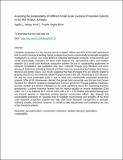| dc.description.abstract | Livestock production is a key income source in eastern Africa, and 80% of the total agricultural land is used for livestock herding. Hence, ecological and socio-economically sustainable rangeland management is crucial. Our study aimed at selecting operational economic, environmental and social sustainability indicators for three main pastoral (P), agro-pastoral (AP), and landless intensive (LI) small scale livestock production systems for use in sustainability assessment in Ethiopia. Quantitative and qualitative data were collected through grey literature and semi-structured interviews, assessing livestock and feed resources, production technology, land tenure, financial and gender issues. Our results suggested that feed shortages (FS) are directly related to grazing pressure (G) and inversely related to grass recovery rates (R). According to our indicators, AP was the most sustainable while P and LI were only conditionally sustainable production systems. 93% of 82 interviewees claimed that private land ownership was the best land tenure incentive for efficient rangeland management. Farmers perceived Prosopis juliflora expansion, sporadic rainfall, and disease infestation as the most significant causes for decreasing livestock productivity. Landless intensive farmers had the highest equality in income distribution (Gini Index: GI = 0.4), followed by P and AP (each with a GI = 0.5). Neither educational background nor income seemed to determine grazing species conservation efforts. We claimed that sustainability indicators are valuable tools to highlight shortcomings and strengths of the three main livestock production systems and help with future livestock management in Ethiopia. Selecting suitable indicators, however, is crucial as data requirements and availability can vary across livestock systems | en_US |

